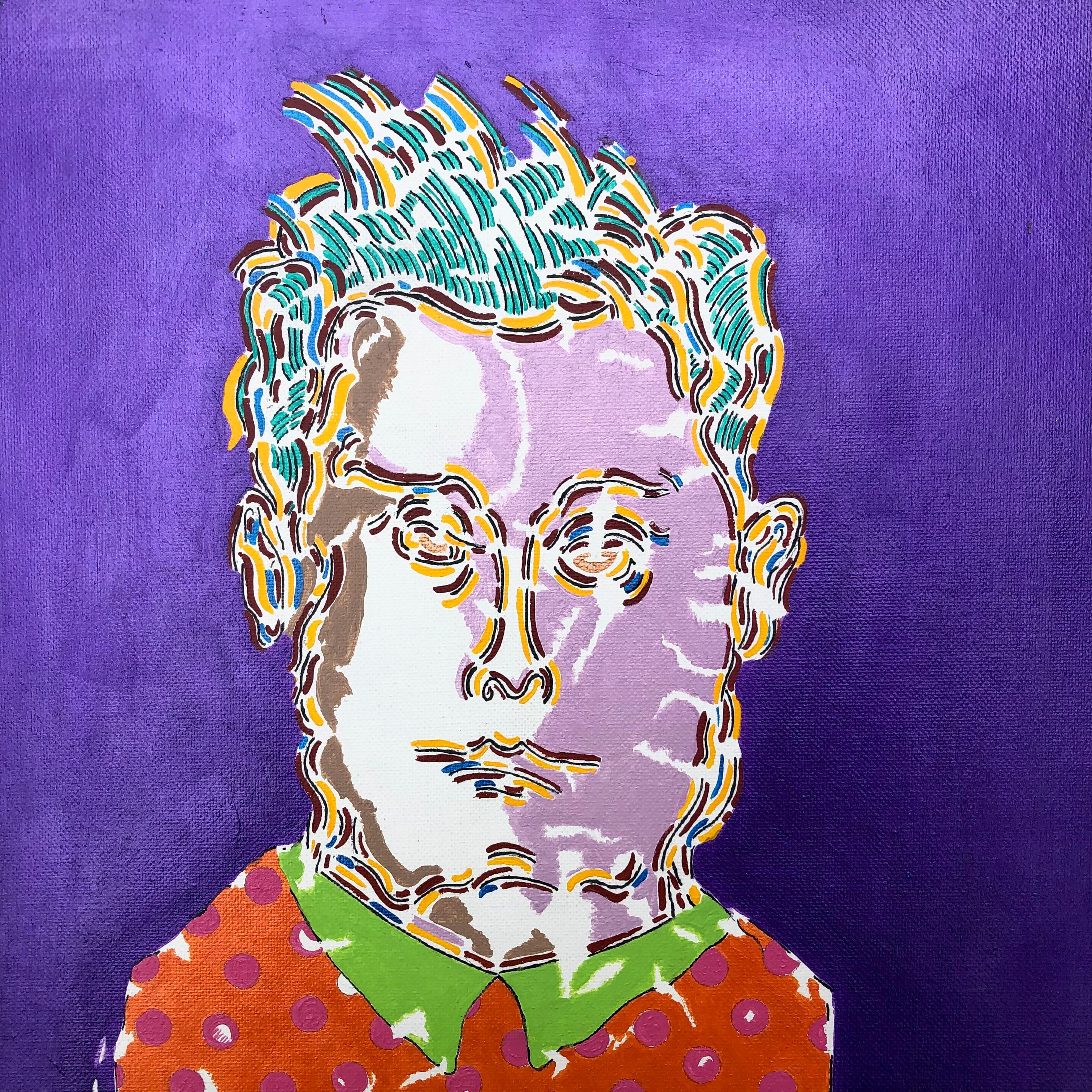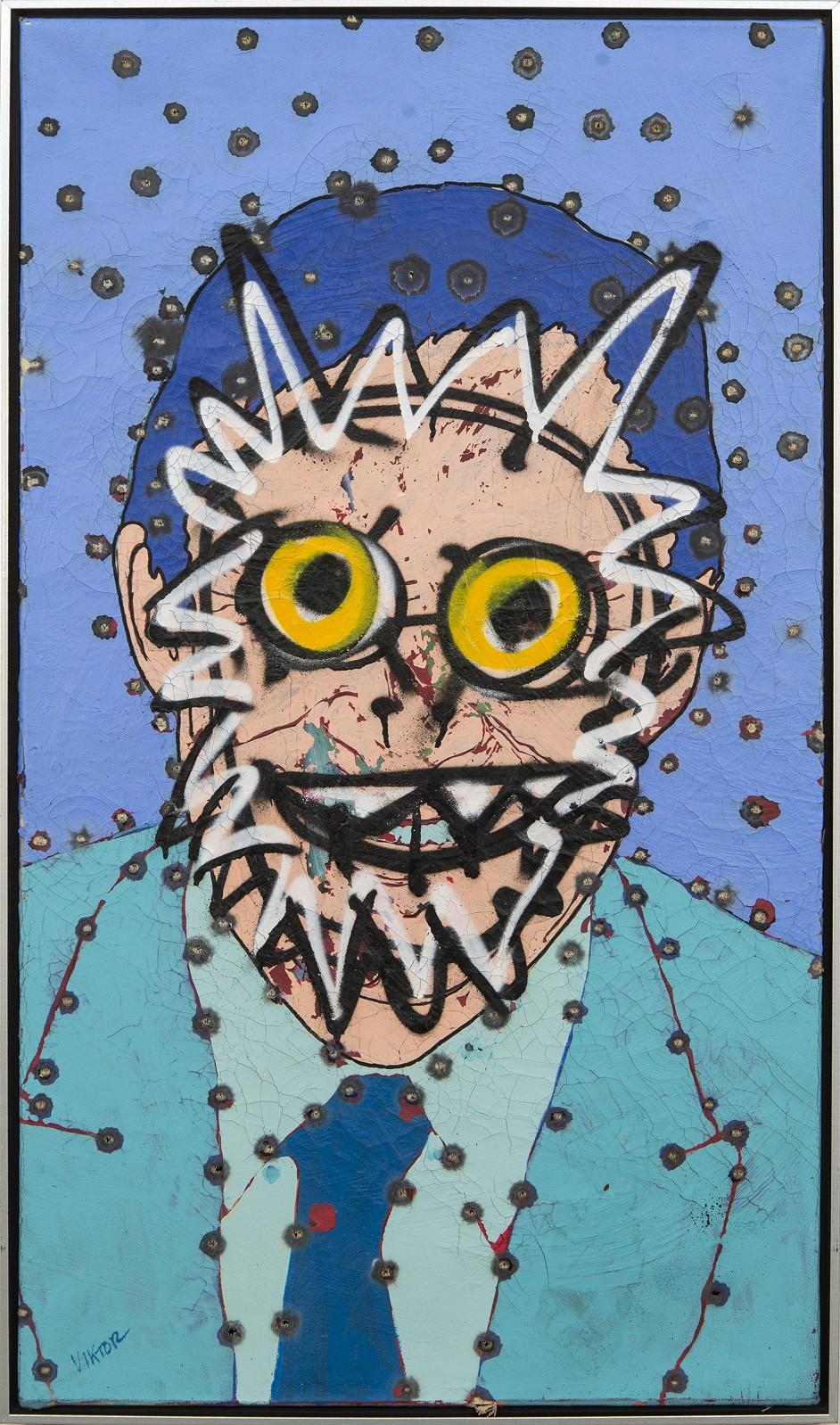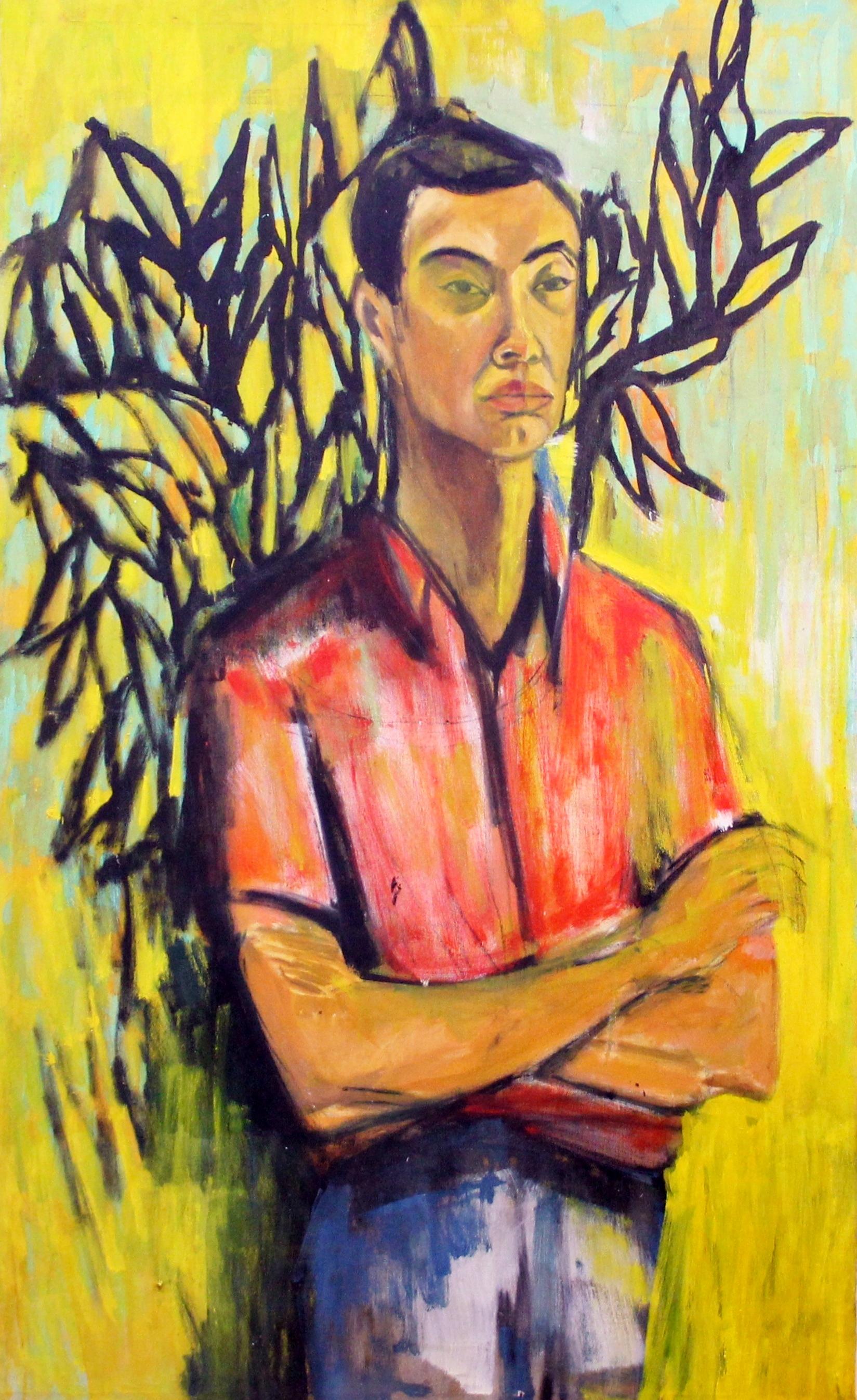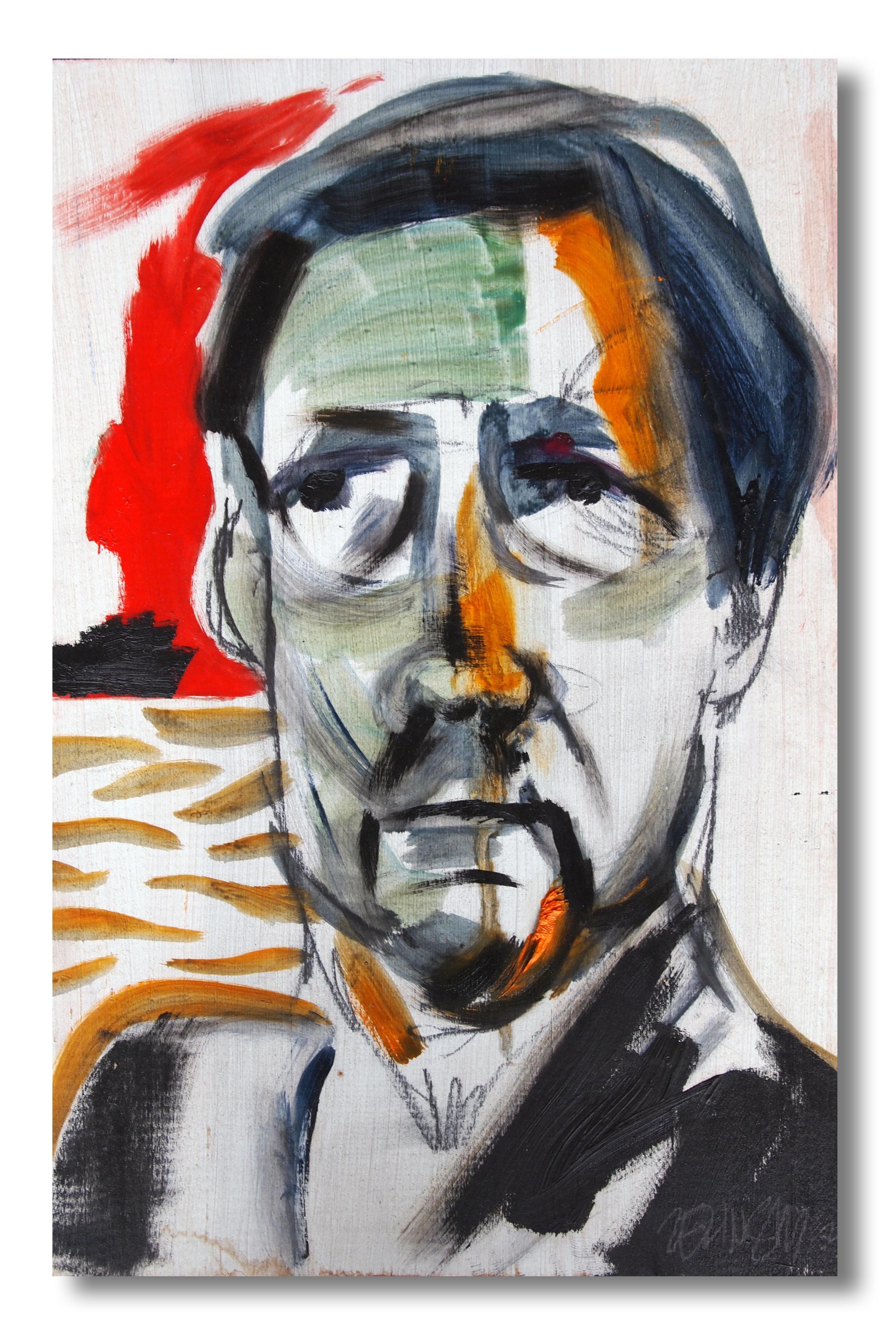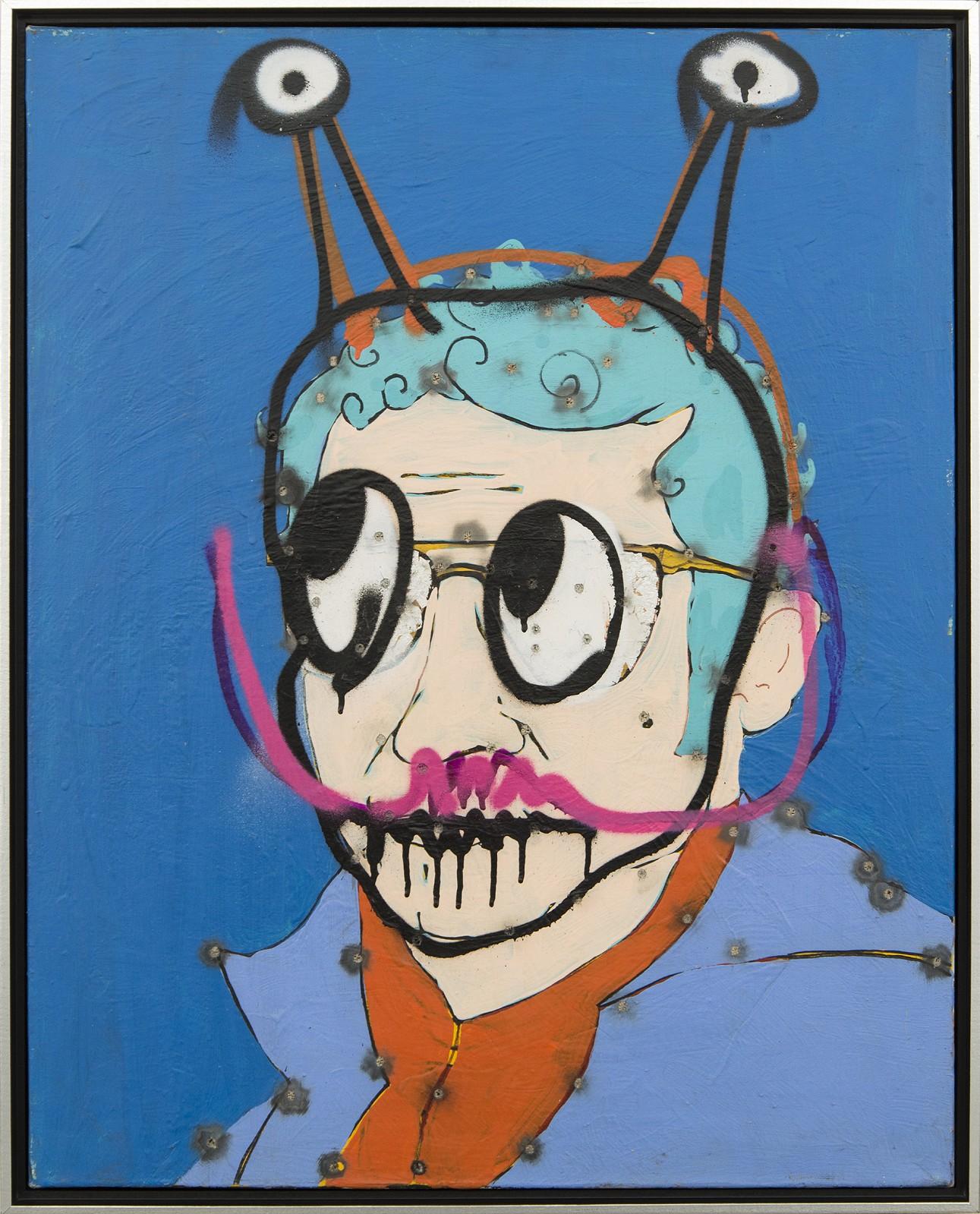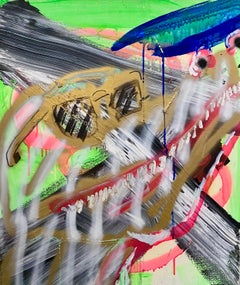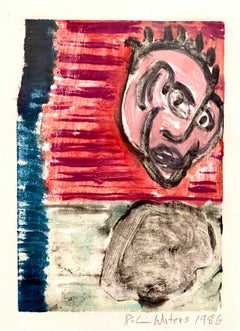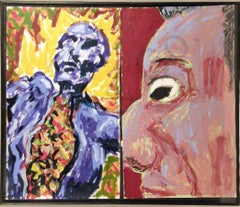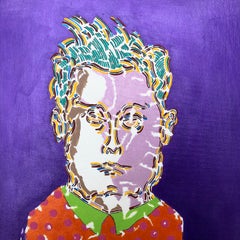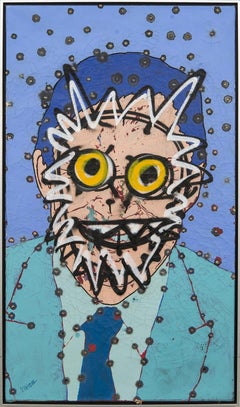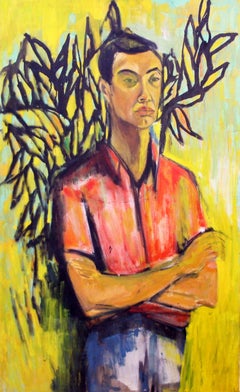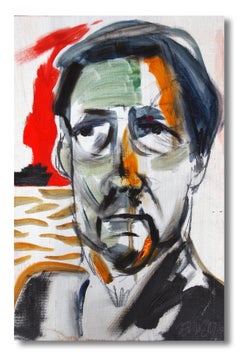Items Similar to Figurative Expressionist Bold Pop Art Oil Painting Self Portrait Carlo Pittore
Want more images or videos?
Request additional images or videos from the seller
1 of 11
Carlo PittoreFigurative Expressionist Bold Pop Art Oil Painting Self Portrait Carlo Pittore1984
1984
$3,500
£2,658.34
€3,057.57
CA$4,890.19
A$5,453.11
CHF 2,845.20
MX$66,911.72
NOK 36,214.87
SEK 34,312.81
DKK 22,819.80
Shipping
Retrieving quote...The 1stDibs Promise:
Authenticity Guarantee,
Money-Back Guarantee,
24-Hour Cancellation
About the Item
Carlo Pittore
Oil on canvas, 1984,
Self Portrait, initialed and dated lower left,
slat framed, 21"sqr (frame) 20 X 20 canvas.
Provenance: The Private Collection of Wolf Kahn & Emily Mason
Carlo Pittore (1943 – 2005) born Charles J. Stanley was an American painter, educator, art activist, and publisher, whose primary study, teaching and body of work was figurative art and portrait painting. He was a pioneer in the Mail Art movement, he corresponded with such mail art luminaries as Buster Cleveland and Ray Johnson. Pittore is noted for opening the first independent art gallery in the East Village, Manhattan. In 1987, Pittore founded "The Academy of Carlo Pittore" in Bowdoinham, Maine.
Pittore (née Charles Stanley) was born to Stanford and Estelle Stanley in Queens, New York. He grew up on Long Island, in Port Washington, New York with his sister Marion and brother Elliott. Pittore graduated from Port Washington High School (1961), where he was active in the political and debating scenes. He then went on to graduate from the School of the Museum of Fine Arts at Tufts (1966), and post graduate from the Brooklyn Museum Art School (1978).
Pittore changed his name in the 1970s while studying abroad in Rome, Italy. The children nicknamed him "Carlo Pittore", (”Charles the Painter"). From there he went on to study at the Chelsea College of Arts in London.
In 1978, Pittore received the Max Beckmann Scholarship in Advanced Painting. It allowed him to begin studying with American feminist painter Joan Semmel at the Brooklyn Museum Art School. He also studied with visual portrait artist Alice Neel. After which, he taught art at the New York Cultural Foundation.
In the 1970s, Pittore and his close friend Bern Porter published mail art under the stamp series “Post Me”, which he published through "Pittore Euforico, New York". Pittore also published such works as "Maine Moments in New York" (1979), "Colleagues" (1979), The Adventures of Carlo Pittore" (1979) and "Salva la Campagna Romana" (1982). Pittore illustrated the book ‘’Bern! Porter! Interview!’’ with original rubber and mail stamps.
Pittore opened “La Galleria dell'Occhio” in 1980. It was the first independent art gallery in the East Village, New York City. Well known as a street level window art space open 24 hours a day, 7 days a week, it was during this time that Pittore met and became acquainted with artists such as Chuck Welch (a.k.a. the Cracker Jack Kid), Ray Johnson, and Pop Art masters Keith Haring and Andy Warhol. Pittore painted Haring from life, a fact which Haring, a student at the School of Visual Arts at the time, mentions in his journals. Pittore's works have been shown in such places as Italy, Belgium, Tokyo, Chicago, New York (Museum Modern Art, Getty Institute for Art History & The Humanities, New York City Public Library), Los Angeles, Spain, Norway; and now hang in private collections throughout the world.
Due to the devastation caused by the outbreak of HIV/AIDS in the 1980s, Pittore left the lower East Side of Manhattan and moved to Maine permanently. In 1987 he founded "The Academy of Carlo Pittore" in Bowdoinham, Maine. Here he invited artists from all over to come and share their knowledge and talents in an academic forum; whilst he himself hosted drawing classes, painted and drew the artists (and models) and also cooked for them. The full portrait of Pittore that emerges in interviews with those who knew him is a collage of Neal Cassady, Pablo Picasso, and Emeril Lagasse. Pittore founded the “Union of Maine Visual Artists” in 1975. The UMVA passed into state law the “Maine Percent for Art Program” and the “Artist’s Estate Tax Law”. From 1978 to 1980, he was a council member for the "Comprehensive Employment Training Act Artists Project" in New York City.
Just before his death in 2005, the Maine College of Art awarded Pittore an honorary Doctorate of Fine Arts. The "Carlo Pittore Foundation for the Figurative Arts" was founded in 2006.
Carlo was a thoroughgoing humanist devoted to the human figure. He drew and painted just about everyone he knew. His nudes and portraits are very much like the man himself — bold, boisterous even, frank, sensuous, and uncompromising. His oeuvre includes paintings of boxers, carnival performers, modern takes on classical paintings, portraits, self-portraits, nudes, landscapes, mail art, and his comic drawings. A figurative painter in the mkodernist manner of Lucian Freud or Alex Katz, Pittore painted in the figurative expressionist and portraiture style; focusing mainly on the nude form of study. On account of this, critics and objectors occasionally viewed his work as "erotic" rather than objective art. Throughout his life, Pittore was extremely vocal toward such critics and what he perceived to be "ignorance" toward his art or art in general. He refused the title of Gay artist. He did not shy away from either voicing his opinion in letters to the editor or removing his exhibits from art galleries or public showings. The colors red and green (symbols of the Italian flag) were two essential components in Pittore's work that defined his belief and understanding of complementary palette application. The contrast of these two color schemes arise time and again throughout his works; as can be seen in "Portrait of Blair Tily" (1987), "Opera - Self Portrait" (1981), "La Buffonera" (1983), and "Portrait of a Skeptic" (1996). Pittore's "Lincoln Portrait Series" was the only oil-on-canvas medium in which he worked without color. For this, he painted entirely in black and white due to the fact that the portraits were modeled after 19th-century photographs of Abraham Lincoln.
Wolf Kahn (1927 – 2020) was a German-born Jewish American painter. Kahn, known for his combination of Realism and Color Field, worked in pastel, oil paint, and printmaking. He studied under Hans Hofmann, and also graduated from the University of Chicago. Kahn was a resident of both New York City and, during the summer and autumn, West Brattleboro, Vermont.
- Creator:Carlo Pittore (1943 - 2005)
- Creation Year:1984
- Dimensions:Height: 21 in (53.34 cm)Width: 21 in (53.34 cm)
- Medium:
- Movement & Style:
- Period:
- Condition:
- Gallery Location:Surfside, FL
- Reference Number:1stDibs: LU38210804722
About the Seller
4.9
Platinum Seller
Premium sellers with a 4.7+ rating and 24-hour response times
Established in 1995
1stDibs seller since 2014
1,782 sales on 1stDibs
Typical response time: <1 hour
- ShippingRetrieving quote...Shipping from: Surfside, FL
- Return Policy
Authenticity Guarantee
In the unlikely event there’s an issue with an item’s authenticity, contact us within 1 year for a full refund. DetailsMoney-Back Guarantee
If your item is not as described, is damaged in transit, or does not arrive, contact us within 7 days for a full refund. Details24-Hour Cancellation
You have a 24-hour grace period in which to reconsider your purchase, with no questions asked.Vetted Professional Sellers
Our world-class sellers must adhere to strict standards for service and quality, maintaining the integrity of our listings.Price-Match Guarantee
If you find that a seller listed the same item for a lower price elsewhere, we’ll match it.Trusted Global Delivery
Our best-in-class carrier network provides specialized shipping options worldwide, including custom delivery.More From This Seller
View AllMixed Media Oil Painting and Spray Paint Abstract Painting Selbstportrait
By Kadar Brock
Located in Surfside, FL
"Selbstportrait Und Der Sonne"
This work is part of a series of alligator paintings Brock made in 2007. All are painted in a somewhat similar and b...
Category
Early 2000s Contemporary Abstract Paintings
Materials
Canvas, Oil, Spray Paint, Acrylic
Conceptual Pop Art Color Oil Monotype Painting Abstract Figure Robin Winters
By Robin Winters
Located in Surfside, FL
Robin Winters (American, born 1950),
Untitled (Red Face) from "Cherry Block Series" 1986, monotype, pencil signed and dated lower right, plate: 6"h x 8.5"w, overall (with frame): 22.25"h x 18.25"w. Provenance: Property from a Private Collection, San Francisco.
Winters was invited to make monotypes at Experimental Workshop in San Francisco, (they printed Richard Bosman, Sam Francis, Claire Falkenstein, Deborah Oropallo and Kenneth Noland and many more greats). Winters chose to paint on wood blocks rather than the more usual metal plates in order to capture the organic quality of the natural material. He exploited a salient characteristic of the monoprint in Ghost Story by adding new painted elements onto the increasingly faint ghost images that result from successive impressions from a single block. In so doing he achieved the effect of transparent layers of color and shadow imagery. Winters's brightly-colored monotypes portray an array of figures and landscapes (and an occasional still-life) that, although can be seen in the context of a general trend away from abstraction that has marked the 1980s, defy strict stylistic categorization. They are neither realistic nor abstract, psychological self-examinations nor narrative fictions, but they contain elements of all of these approaches. Like Jonathan Borofsky, Winters derives much of his subject matter from dreams, believing that through his private fears and obsessions he can touch similar emotions in others. Although at first glance Winters's images look as if they could have been made by a child, closer attention reveals sly art historical references to Jackson Pollock and Pattern Painting (the drip and splatter backgrounds), Mark Rothko (the three-part horizontal compositions) and Minimalism (the gridded Cherry Block Series: Bread Beat).
Robin Winters (born 1950 in Benicia, California) is an American conceptual, multi-disciplinary, artist and teacher based in New York. Winters is known for creating solo exhibitions containing an interactive durational performance component to his installations, sometimes lasting up to two months. Winters first emerged in the burgeoning Soho NYC art scene of the 1970s. An early practitioner of the Relational Aesthetics (social interaction as an art medium) Winters also created in works through sculpture, installation, performance, painting, drawing and prints. His art maintains a whimsical spirit, and he often returns to ongoing themes involving faces, boats, cars, bottles, hats and jesters or fools. Winters has incorporated such devices as blind dates, double dates, dinners, fortune telling, and free consultation in his performances. Throughout his career he has engaged in a wide variety of media, such as performance art, film, video, writing prose and poetry, photography, installation art, printmaking, drawing, painting, ceramic sculpture, bronze sculpture, and glassblowing.
Winters was born in Benicia, California in 1950 to lawyer parents. As a child his hobby was collecting glass bottles found on the beach and under old buildings, which would later influence him as an artist. In 1968, Winters had his first durational performance, entitled Norman Thomas Travelling Museum. The artist drove a Volkswagen bus decorated in collage, many of the images relating to current events and politics. Inside was what the artist described as a “reliquary” containing many objects, including a bottle collection. Winters took the van to shopping centers and even as far as Mexico. That same year, Winters opted not to register for the military draft. Although he was deemed fit to serve, Winters refused. In 1975 the resulting legal proceedings finally came to a close after it was proven that the artist had been harassed by the local draft board. In his teens and early twenties, Winters became acquainted with several local artists who helped shape his aesthetic, most notably Manuel Neri and Robert Arneson. By the early 1970s, Winters was studying at the San Francisco Art Institute (SFAI) and had relocated to San Francisco. At this time Winters became friends with the Bay Area conceptual artists Terry Fox and Howard Fried, and participated in several of Fried's performance works. In 1972 Winters was accepted into the Whitney Independent Study Program in New York City. After coming to New York City, Winters helped support himself by working for various artists, among them the performance artist Joan Jonas and sculptor Donald Judd. In 1974, Winters performed The Secret Life of Bob-E or Bob-E Behind the Veil eight hours a day, five days a week for a month in his studio apartment. Behind a one-way mirror the audience could watch Winters play the character of Bob-E, whose goal was to make a monument for everyone in the world in the form of blue and yellow rubber top hats. By the end of the month the artist had constructed 262 hats. The following year, Winters was invited to take part in the Whitney Museum's 1975 Biennial Exhibition. Entitled W.B. Bearman Bags a Job or Diary of a Dreamer. Winters was traveling in 1975 and 1976, spending time in North Africa and in Europe. At a time when most young American artists were unaware of their European counterparts, Winters met and was influenced by such artists as Sigmar Polke and Marcel Broodthaers (with whom Winters worked on an installation) and also had a one-person exhibition, at the Konrad Fischer Gallery in Dusseldorf. Returning to New York in 1976, Winters teamed up with a group of artists to form Collaborative Projects (Colab), a rather anarchistic organization dedicated to artistic collaboration and the creation of art that questioned social values.. Also in 1976, Winters formed the partnership “X&Y” with fellow artist Coleen Fitzgibbon that would last two years. Together they performed a series of shows in the Netherlands, most notably a show entitled Take the Money and Run. Performed at De Appel in Amsterdam, the show involved the artists robbing their audience. The following day the audience was given an apology, as well as the opportunity to retrieve any valuables and participate in a lottery to win the artists’ services. They also made a Super 8 film in NY called Rich-Poor, in which they asked people on the streets their thoughts on the rich and poor.
In 1980 Winters participated in The Real Estate Show and in Absurdities at ABC No Rio. That same year he and artists Peter Fend, Coleen Fitzgibbon, Peter Nadin, Jenny Holzer, and Richard Prince also formed The Offices of Fend, Fitzgibbon, Holzer, Nadin, Prince & Winters. This short-lived collective was based out of an office on lower Broadway and offered “Practical Esthetic Services Adaptable to Client Situation”, as stated on their business card. Their goal was to offer their art as “socially helpful work for hire”. In June of that year Winters participated in The Times Square Show, Colab's most well-known exhibition. The month-long show took place in a four floor building on West 41st Street and was densely packed with art. To cap off a busy year, Winters also became one of the first artists to join the Mary Boone Gallery, showing a successful solo exhibition in 1981. His work was shown in the New York/New Wave show in 1981 at MoMA PS1 along with Jean-Michel Basquiat, Roberta Bayley, William S. Burroughs, David Byrne, Sarah Charlesworth, Larry Clark, Crash (John Matos), Ronnie Cutrone, Brian Eno, Peter Fend, Nan Goldin, Keith Haring, Ray Johnson, Joseph Kosuth, Marcus Leatherdale, Christopher Makos, Robert Mapplethorpe, Elaine Mayes, Frank Moore, Kenny Scharf and others. In 1982, Winters had his first solo exhibition in Los Angeles at the Richard Kuhlenschmidt Gallery. At the Mo David Gallery in 1984, Winters created an installation piece that consisted of a floor of plaster tiles. Underneath each tile, hidden from view, was a drawing. He designed the stage sets for the musician Nico, and assisted French artist Orlan, American artist Stuart Sherman, and American poet Gregory Corso. Two years later Winters was invited to take part in Chambres d’Amis (In Ghent there is Always a Free Room for Albrecht Durer) in Ghent, Belgium. In it, 51 artists created installations in 50 different sites, mostly private homes. Winters chose the home of a local art historian. The artist made 90 drawings based on images found in the large collection of art books in the home's library. He made two copies of each drawing and placed the originals in the books themselves. One set of copies was exhibited in the sponsoring museum, Museum van Hedendaagse, as "The Ghent Drawings". The drawings were also on display at Winters’ solo exhibition at Luhring Augustine & Hodes Gallery in New York City in 1987.
In 1986, Winters had a solo exhibition at Maurice Keitelman Gallery in Brussels, Belgium, and the following year a solo exhibition at the Centre Régional d'Art Contemporain Midi-Pyrénées in Toulouse, France. Also in 1986, Winters' Playroom was held at the Institute for Contemporary Art in Boston, Massachusetts. The exhibition was part of Think Tank, a retrospective of Winters' work which traveled to the Stedelijk Museum in the Netherlands, the Centre Regional d’Art Contemporain in France, and the Contemporary Arts Center in Ohio. Winters spent a month in 1989 working with students at the San Francisco Art Institute. Never having worked with ceramics, he spent the month making numerous ceramic pieces, which were then shown in the aptly named One Month in San Francisco. Other components of the piece included Winters’ childhood bottle collection and a video showing each piece in the show filmed briefly next to a ruler.[ Also that year, Robin served as a visiting artist at the Pilchuck Glass School, where he met artist John Drury, who was then working as the school's artist liaison.
In the summer of 1990, Winters interviewed fellow artist Kiki Smith for her eponymous book, which was published later that year. That same year (1990), Winters was invited by the Val Saint Lambert glass factory in Belgium to create glassworks in their facility. Winters, artists John Drury and Tracy Glover...
Category
1980s Pop Art Figurative Paintings
Materials
Monoprint, Monotype
Large Archie Rand Abstract Expressionist Cartoon Oil Painting Dusseldorf
By Archie Rand
Located in Surfside, FL
"Dusseldorf, Germany" 1993, oil on canvas, hand signed and dated lower left,
Canvas (unframed):18 X 48. framed: 19.5 X 49.5
Provenance: directly from the artist. Exhibited at Phyllis Kind Gallery in NYC in 1987.
Archie Rand (American, born 1949) is an artist from Brooklyn, New York.
Rand's work as a painter and muralist is held in the collections of the San Francisco Museum of Modern Art, the Art Institute of Chicago, the Victoria and Albert Museum in London, the Bibliothèque Nationale de France in Paris, and the Tel Aviv Museum of Art.
His graphic works and books are held by the Metropolitan Museum Of Art, the Museum of Modern Art, the Whitney Museum of American Art, the Art Institute Of Chicago, The Brooklyn Museum, the Baltimore Museum of Art, the Smithsonian Institution, and The New York Public Library; and are owned by Harvard, Yale, Columbia, Brown, and Johns Hopkins universities.
Born in Brooklyn, Rand received a Bachelor of Fine Arts in cinegraphics from the Pratt Institute, having studied previously at the Art Students League of New York.
His first exhibition was in 1966, at the Tibor de Nagy Gallery in New York. He has since had over 100 solo exhibitions, and his work has been included in over 200 group exhibitions.
He is currently Presidential Professor of Art at Brooklyn College which granted him the Award for Excellence in Creative Achievement in 2016. Before joining Brooklyn College, Rand was the chair of the Department of Visual Arts at Columbia University.
The Italian Academy For Advanced Studies in America at Columbia University presented him with The Siena Prize in 1995. He was awarded a Guggenheim Foundation Foundation Fellowship in 1999 and was made a Laureate of the National Foundation for Jewish Culture, which awarded him the Achievement Medal for Contributions in the Visual Arts. In 2002 he received the Presidential Award for Excellence in Teaching from Columbia University.
In 2002 he became the artistic advisor to film director Ang Lee for his production of The Hulk, and was asked by Milestone Films to provide a commentary track for the DVD release of Henri-Georges Clouzot’s classic 1955 film The Mystery of Picasso.
Archie Rand’s earliest major works are “The Letter Paintings” (or “The Jazz Paintings”) (1968–71), a radically positioned series of technically inventive, mural-sized canvases. The Letter Paintings, by incorporating the names of mainly male and female African-American musicians, undermined prevailing aesthetic categories by conflating many contemporary movements including Conceptual Art, Color Field, Pattern and Decoration, diary entry and social commentary.
In 1974 Rand received a commission from Congregation B’nai Yosef in Brooklyn. Rand was asked to paint thematic murals on the complete 16,000-square-foot (1,500 m2) interior surfaces of the synagogue. The work took three years, and completing this commission made Rand the author of the only narratively painted synagogue in the world and the only one we know of since the 2nd Century Dura-Europos. The religious legal controversy raised by placing wall paintings in a traditionally iconoclastic space was resolved by the verdict of Rabbi Moshe Feinstein, then considered to be the world’s leading Talmudic scholar, who declared the paintings to be in conformity with the law. His subsequent turn to figuration may have been influenced by his friendship with Philip Guston, whose own work was transformed in the late 1960s. Like Guston, Rand "chafed at the limitations of purely abstract forms."
A near-cult figure who started out as a child prodigy and whose admirers range from John Ashbery to Julian Schnabel. Rand’s paintings display a vast and savvy menu of inventive and finely executed approaches. He has completed many series after the works of Paul Celan, Moyshe-Leyb Halpern, Eugenio Montale, Yehuda Amichai, Rainer Maria Rilke, Samuel Beckett/Paul Eluard and Jack Spicer. Working often with poets, he has produced books and continues to engage in publishing collaborative projects. He maintained a correspondence with the American British Jewish painter R.B. Kitaj.
In 2008, on a warehouse wall, Rand mounted the painting, “The 613”, which at 1700 square feet (17’ x 100’) is nearly twice the size of James Rosenquist’s F-111. It is one of the largest freestanding paintings ever made. Reminiscent of “The Segments” paintings it is intimidatingly enormous. Paradoxically, despite the raucous cartoony bytes that shoot colorful flashes from the manic surface, “The 613” glows warmly. Its overall effect is strangely calming and majestic.
In an article on a 2011 exhibition of Rand's "Had Gadya" series, David Kaufmann wrote:
Rand displayed his work in 15 solo exhibitions between 2008 and 2017, many of them showcasing paintings done after Scripture, or his workings with poets: Including “Had Gadya, 2005”, Borowsky Gallery, Philadelphia, PA (2011); “Gods Change, Prayers Are Here To Stay (after Yehuda Amichai), 2000", Katz Gallery, Atlanta, GA (2014); “Psalm 68, 1994”, Derfner Museum, Riverdale, NY (2014); “The Chapter Paintings”, Tribeca Gallery, NY (2015); “Men Who Turn Back (after Eugenio Montale), 1995", SRO Gallery, Brooklyn, NY (2016); “Sixty Paintings From the Bible” & “The Book of Judith, 2012”, Cleveland State University Galleries, Cleveland, OH (2016) & The American Jewish Museum, Pittsburgh, PA (2017); “Archie Rand: Early Works With Poetry: Jack Spicer, 1991 and Samuel Beckett/Paul Eluard, 1993”, St. Francis College, Brooklyn, NY (2017).
"The 613"
In 2015 Blue Rider/Penguin/Random House published The 613, allotting one color plate per page for each of the 614 units in the painting. The Wall Street Journal labeled The 613 as “dynamic…remarkable…thrilling” The New York Times selected the book as “Editors' Choice” and praised it in two separate reviews calling it “wonderfully garish” and declaring that “nothing prepared the art world for 'The 613.'
Recent Activity
In 2016 Rand showed two bodies of work that were done in Italy, “La Certosa Di Pontignano, 1995” and “Mount Etna, 2005,” at The Interchurch Center Galleries, New York. From 2016 to 2017 he served as the Curator and Juror for the Governor of Wyoming’s Capitol Arts Exhibition at The Wyoming State Museum, Cheyenne, WY.
A 2017 exhibition, “Archie Rand: Early Works With Poetry”, featured two series of work from 1991 and 1993 after poems by Jack Spicer and Samuel Beckett/Paul Eluard.
This painting was exhibited in the Phyllis Kind Gallery in NY in 1987.
(Phyllis Kind was an American art dealer active in Chicago and New York. She promoted the work of the Chicago Imagists, The Monster Roster and The Hairy Who and outsider artists. Kind opened a gallery in Chicago in 1967. Called Pro Grafica Arte, the gallery dealt in master prints and drawings. In 1975, she opened a gallery on Spring Street in New York's SoHo district. She gave some of the artists in the movement their first solo shows: Jim Nutt and Gladys Nilsson...
Category
1980s American Modern Figurative Paintings
Materials
Canvas, Oil
UNTITLED, 1981 DIPTYCH Neo Expressionist Figures Peter Julian Oil Painting
By Peter Julian
Located in Surfside, FL
Peter Julian (born 1952 in Buffalo, New York) is an American artist best known for his Neo-expressionist paintings in the 1980s. His first major exhibition was in New York in 1982 at The New Museum as part of the museum’s annual “New Work/New York” series of exhibitions. THis piece is from that exhibition.
(New Work / New York. 1982; 34 pages; staple-bound; 34 pages; 44 b/w illustrations. Essays by Lynn Gumpert and Ned Rifkin. Foreword by Marcia Tucker. Artists: Tom Butter, Tom Evans, John Fekner, Judith Hudson, Peter Julian, Cheryl Laemmle...
Category
1980s Neo-Expressionist Figurative Paintings
Materials
Paper, Oil
Large Venezuelan Expressionist Oil Painting Diego Barboza Latin American Master
Located in Surfside, FL
Diego Barboza - 1945-2003
Hand signed and dated 1988 Oil on Canvas
Diego Barboza was born the Carabobo street of Maracaibo, Venezuela on February 4, 1945. He was a Venezuelan Neo Figurative Painter who is among the most famous and influential figures in Venezuelan art history. Diego Barboza opened a new chapter in Latin America, beyond the surreal or the magical realism of the Modern Latin American Masters. He created a new language of dislocation and transgression. Personages became distorted to the point that was very exaggerated forms His figures twisted and contorted without losing their presence or their pull. Extremities muscles, and bones burst into an explosive compound of divergent and convergent lines. Through eruptive brushstrokes and fractured outlines. Barboza created a world of illusions.
Barboza was born into a upper-middle-class family. He stopped going to school at 12 years old, and he registered himself at the School of Visual Art in the City of Maracaibo Venezuela. Barboza studied at the School of Visual Arts in Caracas, Venezuela. Barboza began his training as an artist at age 12 in his native Maracaibo when he left formal education to enroll in the then School of Plastic Arts of Zulia, then Julio Arraga School of Plastic Arts, where he was a student in the modeling, collage and Drawing of Angelina Curiel. His first collages, in the sixties, show the influence of American Pop Art. In 1967 he exhibited at the Ateneo de Caracas his series 'Los Ratones', a proposal then 'criticized by critics as unprecedented in Venezuela'. In his tribute to the film "Nosferatu" Friedrich Murnau included 32 drawings as well as two-dimensional objects. In 1968 he moved to London where he studied at the London College of Printing. From that time is his '30 Girls with Nets', an action in which 30 students of the London College of Printing, dressed in black and covered by white nets, toured London public places, behaving naturally. His 'street expressions', which he later called 'poetic actions', symbolized a breakdown of social restraints through unusual behaviors that sought to provoke public reactions. Upon his return to Venezuela in 1973, Barboza continues with this line of work, being recognized as one of the initiators of Venezuelan conceptual art. In the 1980's Diego Barboza turned to painting, the New Venezuelan Figuration. Here belongings and the feminine figure fill the work of that time, in which he embodied his intimacy and daily life through scenes of furnishings and flowers that included objects from his workshop and home. His nudes were made from live model, then to follow the path of distortion resulting in their unmistakable females: a figure that represented their personal way of appreciating beauty. Barboza presented his first individual exhibition at the Centro de Bellas Artes of Maracaibo Venezuela. In 1963, he traveled to London when the Conceptual Art movement started, he had the support of the London New Art Lab Gallery. On March 7, 1970 Barboza displayed his first work on Conceptual Art, which he called Art of Action. In London with the performance of 30 Girls with nets (30 Muchachas con redes). His second work was Nets and Hats in markets and restaurants (Con sombreros y redes en mercados y restaurantes). In London UK. His third The Centerpiece (El Ciempies) and the fourth Expression on a laundry-mat (Expresiones en una lavandería)
In 1974. Baboza returned to Venezuela. Where he presented two very important Conceptual Art works: The Armadillo Box (La Caja del Cachicamo) and from the School of Athens to the New School of Caracas (De la Escuela de Atenas a la Nueva Escuela de Caracas). Closing his cycle of Conceptual Art creation. IN Venezuela a sort of impromptu academy started up at Claudio Perna’s house. Eugenio Espinoza, Roberto Obregón, Antonieta Sosa, Alfred Wenemoser, Yeni and Nan, Sigfredo Chacón, Diego Barboza, Luis Villamizar, Margherita D’Amico, Pedro Terán, Alfredo del Mónaco, as well as international figures who happened to be visiting Venezuela such as Antoni Muntadas, Charlotte Moorman, and Roman Polanski would gather there. Venezuela, especially Caracas, was a rich field of action for modernism in South America. Venezuelan Geometric Abstraction, Op art and Kinetic Art dominated through crucial figures like Jesús Rafael Soto, Gego, Alejandro Otero, and Carlos Cruz Diez, the country’s kinetic art made a fundamental contribution internationally. The Greater London Arts Association and the Arts Council of Great Britain did several exhibitions of (North, Central, South, London, Wales, Scotland and Ulster) to show the actual Visual Arts in all of the United Kingdom and Diego Barboza was invited for this event with a solo exhibition, expressions around a cylinder (Expresiones alrededor de un cilindro).
Diego has made numerous solo and group exhibitions, obtaining rewards since 1963. He is represented in the most important museums of Venezuela, as well as in England, Brazil, Colombia and Cuba. In 1986 he was awarded the Municipal Visual Arts Award of the Municipal Council of the Federal District and in 1997 he received the National Prize for Plastic Arts granted by the National Council of Culture, CONAC.
Select Group Exhibitions
1964 Ateneo de Caracas, Caracas, Venezuela
1965 Salón Arturo Michelena, Valencia, Venezuela
1968 Salón Oficial Museo de Bellas Artes, Caracas, Venezuela
1971 Art Spectrum London, London, Great Britain
1972 Serpentine Gallery, London, Great Britain
1973 Midland Group Gallery, London, Great Britain
1974 Galería BANAP, Caracas, Venezuela
1975 Casa de Las Américas, La Habana, Cuba
Museo de Bellas Artes, Caracas
Galería de Arte Nuevo, Buenos Aires, Argentina
1976 Museo de Arte Moderno, Bogotá, Colombia
Museo de Arte Contemporáneo, Sao Paulo, Brazil
Museo de la Tertulia, Cali, Colombia
Bienal de Venecia, Venecia, Italy
1979 Centro de Artes y Comunicación, Buenos Aires, Argentina
1980 Galería NBC, Memphis, Tennessee, USA
1981 Galería de Arte Nacional, Caracas, Venezuela
Museo de Arte Contemporáneo, Medellín, Colombia
Museo de Bellas Artes, Caracas, Venezuela
1986 Museo de Arte La Rinconada, Caracas, Venezuela
1989 Galería Venzor, Chicago, Illinois, USA
1990 Museo Bellas Artes, Santiago de Chile, Chile
1992 Ambrosino Gallery, Coral Gables, Florida, USA
1993 Museo de Arte de Petare, Caracas, Venezuela
Centro de Arte Lia Bermúdez, Maracaibo, Venezuela
1994 Galería Namia Mondolfi, Caracas, Venezuela
1995 Galería Art Nouveau, Maracaibo, Venezuela
Galería Cesar Sassòn, Caracas, Venezuela
Maremares Resort, Puerto La Cruz, Venezuela
Galería Durban, Caracas, Venezuela
Galería Odalys, Caracas, Venezuela
1996 Centro de Arte Grupo Li, Caracas, Venezuela
Galería Uno, Caracas, Venezuela
Centro Cultural Consolidado, Caracas, Venezuela
Espacios Unión, Caracas, Venezuela
Hebraica, Caracas, Venezuela
1997 Sociedad Dramática, Maracaibo, Venezuela, Venezuela
CELARG, Caracas, Venezuela
Galería Ocre Arte, Caracas, Venezuela
Museo de Arte Contemporáneo , Maracay, Venezuela
Galería Medicci, Caracas, Venezuela
Awards
1963 Premio Estímulo - IX Salón d’Empaire, Maracaibo, Venezuela
1964 Premio José Ortìn Rodríguez - X Salón d’Empaire, Maracaibo, Venezuela
1965 Primer Premio de Dibujo - III Salón Pez Dorado, Caracas, Venezuela
1968 Premio Henrique Otero Vizcarrondo - XXIV Salón Oficial Anual de Arte Venezolano Museo de Bellas Artes,
1973 Premio Emilio Boggio...
Category
1980s Neo-Expressionist Figurative Paintings
Materials
Canvas, Oil
Portrait of a Gentleman, Large Modernist Oil Painting
By Benjamin Kopman
Located in Surfside, FL
BENJAMIN KOPMAN (1887 - 1965)
Painter, Illustrator and printmaker Benjamin Kopman was born in Vitebsk, Russia and emigrated to the United States with his family in 1903. It was a cen...
Category
Mid-20th Century Expressionist Portrait Paintings
Materials
Canvas, Oil
You May Also Like
That Guy Mike, Original Painting
Located in San Francisco, CA
Artist Comments
"That guy Mike looks nothing like him," says artist John McCabe. "His hair isn't quite so aqua. Maybe they are the same height." He...
Category
21st Century and Contemporary Pop Art Figurative Paintings
Materials
Acrylic
Marc - graphic, portrait, pop-art style, cultural, acrylic painting on canvas
By Viktor Mitic
Located in Bloomfield, ON
Taking caricature portraiture to a new level, Viktor Mitic has portrayed 'Marc' in the guise of a zombified 1950s radio announcer. The bright blocks of co...
Category
2010s Contemporary Figurative Paintings
Materials
Gold Leaf
Self Portrait, Expressionist Figurative Portrait by Philadelphia Artist
By Bernard Harmon
Located in Doylestown, PA
"Self Portrait" is a painting by Philadelphia born Expressionist painter Bernard Harmon. The 47" x 28.5" oil on canvas portrait features Harmon at a young age of about 25 years old. ...
Category
1960s Expressionist Portrait Paintings
Materials
Canvas, Oil
oil portrait, Painting, Oil on Wood Panel
By Edward Zelinsky
Located in Yardley, PA
Portrait of a Dutch friend :: Painting :: Contemporary :: This piece comes with an official certificate of authenticity signed by the artist :: Ready to Hang: No :: Signed: Yes :: Si...
Category
Early 2000s Contemporary Paintings
Materials
Oil
Self Portrait (Selfie) - graphic, pop-art, acrylic painting on canvas
By Viktor Mitic
Located in Bloomfield, ON
Utilizing a pop-inspired aesthetic with bold colour blocks and a simplified portraiture design, Mitic riffs on the ubiquitous selfie culture, comical filters, and more deeply, survei...
Category
2010s Contemporary Figurative Paintings
Materials
Gold Leaf
$5,600 Sale Price
20% Off
One-Of-A-Kind painting on canvas "Crash Kennedy" by Serg Graff, Gold Frame, COA
Located in Palm Coast, FL
This is a rare, unique original acrylic and oil painting on canvas by contemporary visionary artist Serg Graff, titled "Crash Kennedy." Executed in a naïve primitivism style, this bo...
Category
2010s Abstract Impressionist Portrait Paintings
Materials
Acrylic
More Ways To Browse
Erotic Art Painting
Spanish Pop Art
Carlo Painter
Oil Painting Opera
Vintage Comic Art
Portrait Self Collage
Gay Vintage Art
Andy Warhol Self
Gay Portrait
American School 19th Century Portrait Painting
Pop Art Gay
Andy Warhol 1984
Erotic Oil Painting
Oil Painting By Alice
Jewish Pop Art
Oil Paintings Of Jewish Man
Oil Painting Gay
Andy Warhol Self Portrait
